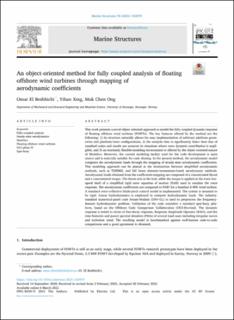| dc.contributor.author | El Beshbichi, Omar | |
| dc.contributor.author | Xing, Yihan | |
| dc.contributor.author | Ong, Muk Chen | |
| dc.date.accessioned | 2021-08-12T11:42:22Z | |
| dc.date.available | 2021-08-12T11:42:22Z | |
| dc.date.created | 2021-08-05T12:00:34Z | |
| dc.date.issued | 2021-07 | |
| dc.identifier.citation | El Beshbichi.O., Xing, Y., Ong, M. C. (2021) An object-oriented method for fully coupled analysis of floating offshore wind turbines through mapping of aerodynamic coefficients. Marine Structures, 78:102979. | en_US |
| dc.identifier.issn | 0951-8339 | |
| dc.identifier.uri | https://hdl.handle.net/11250/2767588 | |
| dc.description.abstract | This work presents a novel object-oriented approach to model the fully-coupled dynamic response of floating offshore wind turbines (FOWTs). The key features offered by the method are the following: 1) its structure naturally allows for easy implementation of arbitrary platform geometries and platform/rotor configurations, 2) the analysis time is significantly faster than that of standard codes and results are accurate in situations where rotor dynamic contribution is negligible, and 3) an extremely flexible modeling environment is offered by the object-oriented nature of Modelica. Moreover, the current modeling facility used for the code development is open source and is naturally suitable for code sharing. In the present method, the aerodynamic model computes the aerodynamic loads through the mapping of steady-state aerodynamic coefficients. This modeling approach can be placed at the intersection between simplified aerodynamic methods, such as TDHMill, and full beam element/momentum-based aerodynamic methods. Aerodynamic loads obtained from the coefficients mapping are composed of a concentrated thrust and a concentrated torque. The thrust acts at the hub, while the torque is applied at the rotor low-speed shaft of a simplified rigid rotor equation of motion (EoM) used to emulate the rotor response. The aerodynamic coefficients are computed in FAST for a baseline 5 MW wind turbine. A standard rotor-collective blade-pitch control model is implemented. The system is assumed to be rigid. Linear hydrodynamics is employed to compute hydrodynamic loads. The industry-standard numerical-panel code Sesam-Wadam (DNV-GL) is used to preprocess the frequency-domain hydrodynamic problem. Validation of the code considers a standard spar-buoy platform, based on the Offshore Code Comparison Collaboration (OC3-Hywind). The dynamic response is tested in terms of free-decay response, Response Amplitude Operator (RAO), and the time histories and power spectral densities (PSDs) of several load cases including irregular waves and turbulent wind. The resulting model is benchmarked against well-known code-to-code comparisons and a good agreement is obtained. | en_US |
| dc.language.iso | eng | en_US |
| dc.publisher | Elsevier Ltd. | en_US |
| dc.rights | Navngivelse 4.0 Internasjonal | * |
| dc.rights.uri | http://creativecommons.org/licenses/by/4.0/deed.no | * |
| dc.subject | marin teknologi | en_US |
| dc.subject | vindturbiner | en_US |
| dc.title | An object-oriented method for fully coupled analysis of floating offshore wind turbines through mapping of aerodynamic coefficients | en_US |
| dc.type | Peer reviewed | en_US |
| dc.type | Journal article | en_US |
| dc.description.version | publishedVersion | en_US |
| dc.rights.holder | © 2021 The Authors | en_US |
| dc.subject.nsi | VDP::Teknologi: 500::Marin teknologi: 580 | en_US |
| dc.source.pagenumber | 1-27 | en_US |
| dc.source.volume | 78 | en_US |
| dc.source.journal | Marine Structures | en_US |
| dc.identifier.doi | 10.1016/j.marstruc.2021.102979 | |
| dc.identifier.cristin | 1924084 | |
| dc.source.articlenumber | 102979 | en_US |
| cristin.ispublished | true | |
| cristin.fulltext | original | |
| cristin.qualitycode | 2 | |

